The process of impeaching a deputy
president is not an easy one. The Constitution of Kenya gives the Senate and
the National Assembly the power to remove the deputy president from the
office.
Over the past few weeks, Orange Democratic Movement (ODM)
MPs and some Senators have demanded that deputy president William Ruto should
resign over alleged gross misconduct.
Almost 40 legislators want the DP removed from office for
allegedly disrespecting President Uhuru Kenyatta. These leaders, led by Siaya
Senator James Orengo, say they will go the constitutional way of impeaching the
deputy president.
But, what does it take to impeach the deputy president in
Kenya?
According to the Constitution, the Deputy president can be
impeached if a motion by a member of the national assembly is supported by a
third of all the members on the grounds of;
(a) physical or mental incapacity to perform the functions
of the office, or
(b) on impeachment;
(i) on the ground of a gross violation of a provision of
this Constitution or any other law;
(ii) where there are serious reasons to believe that he has
committed a crime under national or international law
(iii) for gross misconduct.
This means that out of the 349 MPs, 117 should sign the
motion to remove the deputy president from office.
If two-thirds of the members of the National Assembly
(233MPs) support the motion, then;
- The
Speaker shall inform the Speaker of the Senate of that resolution within
two days; and
- The
Deputy President shall continue to perform the functions of the office,
pending the outcome of the proceedings required by the law.
While all this is happening, the deputy president is
expected to continue performing his duties, pending the outcomes of the motion.
Within seven days after receiving the motion to impeach the
DP, the Speaker of the national assembly shall;
- Convene
a meeting of the Senate to hear charges against the Deputy President; and
- The
Senate, by resolution, may appoint a special committee comprising eleven
of its members to investigate the matter.
The special committee, which involves 11 members of the
Senate, will conduct a trial against the DP and report to the House within
seven days.
Stay informed. Subscribe to our newsletter
Article 145 (4) of the Constitution says,” “The special
committee shall investigate the matter and report to the Senate within 10 days
whether it finds the particulars of the allegations against the deputy president
to have been substantiated.”
At this point, the deputy president shall have the right to
appear before the Senate during the investigations and defend himself.
The Constitution states that “If the special committee
reports that the particulars of any allegation against the deputy president
have been substantiated, the Senate shall, after according the deputy president
an opportunity to be heard, vote on the impeachment charges.”
For the impeachment to be successful, at least two-thirds of
all the members of the Senate, that is, 47 out of 67 senators, will have to
vote to uphold any impeachment charge. Once this happens, the deputy president
shall cease to hold office.
If the committee finds that the allegations are
unsubstantiated, the impeachment ceases, and the deputy president continues to
hold office.
If someone else assumes the office of the DP, the person
shall be deemed “to have served a full term as Deputy President if, at the date
on which the person assumed office, more than two and a half years remain
before the date of the next regularly scheduled election.”
The Constitution also stipulates that the same procedure
used to impeach the deputy president also applies to the removal of the
President with the necessary modifications applying the provisions of Articles
144 and 145.
 The Standard Group Plc is a
multi-media organization with investments in media platforms spanning newspaper
print operations, television, radio broadcasting, digital and online services. The
Standard Group is recognized as a leading multi-media house in Kenya with a key
influence in matters of national and international interest.
The Standard Group Plc is a
multi-media organization with investments in media platforms spanning newspaper
print operations, television, radio broadcasting, digital and online services. The
Standard Group is recognized as a leading multi-media house in Kenya with a key
influence in matters of national and international interest.
 The Standard Group Plc is a
multi-media organization with investments in media platforms spanning newspaper
print operations, television, radio broadcasting, digital and online services. The
Standard Group is recognized as a leading multi-media house in Kenya with a key
influence in matters of national and international interest.
The Standard Group Plc is a
multi-media organization with investments in media platforms spanning newspaper
print operations, television, radio broadcasting, digital and online services. The
Standard Group is recognized as a leading multi-media house in Kenya with a key
influence in matters of national and international interest.








